true
Center for International Stabilization and Recovery
MSC 4902
Harrisonburg, Virginia 22807
Harrisonburg, Virginia 22807
-
 Letter from the Editor: The Journal of Conventional Weapons Destruction Celebrates 25 Years!
Letter from the Editor: The Journal of Conventional Weapons Destruction Celebrates 25 Years!
September 15, 2021: For this 25th edition of The Journal, I invite you to join me in celebrating all the present and past authors who have shared their ideas, inventions, and perspectives to improve the lives of countless communities...
-
 Past, Present, Future: Mine Action in Motion
Past, Present, Future: Mine Action in Motion
September 15, 2021: The story of mine action is one of an adaptive and solution-oriented sector. Time and again, mine action has developed new approaches, tools, and standards to meet evolving challenges and circumstances...
-
 Mine Action: The Early Years
Mine Action: The Early Years
September 15, 2021: This article looks at the challenges and successes of the early days of humanitarian mine action (HMA), particularly in the areas of coordination, standardization, and information sharing...
-
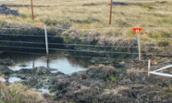 Applying “All Reasonable Effort” in the Falkland Islands Mine Clearance Programme
Applying “All Reasonable Effort” in the Falkland Islands Mine Clearance Programme
September 15, 2021: This article describes the approach that was adopted to determine whether all reasonable effort (ARE) had been applied to each task clearance in the Falkland Islands...
-
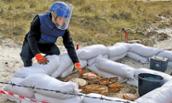 The Exploitation of Landmines in the Falkland Islands
The Exploitation of Landmines in the Falkland Islands
September 15, 2021: The rigorous demining program was highly successful, and the Falkland Islands have now been declared clear...
-
 Linking Mine Action and Development: the Case of Komyshuvacka
Linking Mine Action and Development: the Case of Komyshuvacka
September 15, 2021: The protracted crisis in Ukraine raises many developmental, humanitarian, and mine action challenges, and while these are interconnected, the response to them continues to be dichotomous...
-
 Developing National Landmine Clearance Capacity in Ukraine
Developing National Landmine Clearance Capacity in Ukraine
September 15, 2021: The mine action sector in Ukraine has seen significant growth and progression since the outbreak of hostilities along the eastern border in 2014. Continued development of government capacity is required to respond...
-
 Saving Lives in Eastern Ukraine: Alternative EORE Approaches
Saving Lives in Eastern Ukraine: Alternative EORE Approaches
September 15, 2021: Unexploded ordnance (UXO) and landmines present a threat to the civilian population in Ukraine. Therefore, humanitarian mine action (HMA) remains one of the most important parts of the humanitarian response...
-
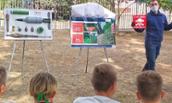 Explosive Ordnance Risk Education in Ukraine During the COVID-19 Pandemic
Explosive Ordnance Risk Education in Ukraine During the COVID-19 Pandemic
September 15, 2021: ERW contamination is a major problem in the Donetsk and Luhansk regions of eastern Ukraine. recent risk education (RE) efforts have been hampered by the ongoing COVID-19 pandemic, which has heavily affected Ukraine...
-
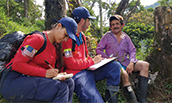 Landmine Clearance and Socioeconomic Development: A Study in Colombia
Landmine Clearance and Socioeconomic Development: A Study in Colombia
September 15, 2021: The HALO Trust (HALO) arrived in Colombia in 2009 and, once accredited, began operations in 2013. HALO is currently the largest civilian humanitarian demining organization in the country...
-
 Impact Caused by the COVID-19 Pandemic on Humanitarian Demining in Colombia
Impact Caused by the COVID-19 Pandemic on Humanitarian Demining in Colombia
September 15, 2021: The COVID-19 pandemic has impacted the mine action sector globally. In this article, the authors look at how the pandemic has affected Colombia, specifically, humanitarian demining...
-
 Moving the Story Forward
Moving the Story Forward
September 15, 2021: The humanitarian mine action (HMA) sector, as a part of the wider security and peacebuilding field, has made significant gains related to gender equity in field operations...
-
 Mental Health: Taking a Proactive Approach to Support Staff in Mine Action
Mental Health: Taking a Proactive Approach to Support Staff in Mine Action
September 15, 2021: This article aims to contribute to existing conversations on how the mine action sector can work together to promote mental health in the workplace...
-
 Digital Rehabilitation Technologies Deliver Hope for Survivors
Digital Rehabilitation Technologies Deliver Hope for Survivors
September 15, 2021: Humanity & Inclusion (HI) has been making prostheses and orthoses since its launch in refugee camps along the Thailand/Cambodia border in 1982, when it was known as Handicap International...
-
 An Innovative Approach to the Mental Health Needs of Humanitarian Mine Action Personnel
An Innovative Approach to the Mental Health Needs of Humanitarian Mine Action Personnel
September 15, 2021: Because of the multiple and unique stressors associated with HMA, personnel likely experience trauma-related mental health conditions at a rate equal to, if not greater than, other high-risk professions...
-
 Data-Driven Decision-Making in Southeast Asia
Data-Driven Decision-Making in Southeast Asia
September 15, 2021: Automated management information systems are becoming more important today. Funding and resources are scarce, but technological developments are making it possible to conduct analyses...
-
 Key Performance Indicators (KPIs) for Land Release and Stockpile Destruction Operations Notes on a New Technical Note for Mine Action
Key Performance Indicators (KPIs) for Land Release and Stockpile Destruction Operations Notes on a New Technical Note for Mine Action
September 15, 2021: In March 2021 the IMAS Review Board adopted by consensus a new Technical Note for Mine Action (TNMA): Key Performance Indicators (KPIs) for Land Release and Stockpile Destruction...
-
 A Virtual Reality Application for the Training of Deminers
A Virtual Reality Application for the Training of Deminers
September 15, 2021: As virtual reality (VR) tools continue to improve, more fields are finding ways of implementing the technology to take advantage of training opportunities that reduce costs, alleviate logistical challenges, and more...
-
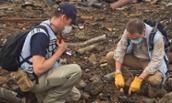 Recognizing and Reducing Risks From Ammunition and Explosives
Recognizing and Reducing Risks From Ammunition and Explosives
September 15, 2021: The GICHD first engaged in the stockpile management of conventional ammunition in 2013 and has since developed in-house technical, operational, and strategic capabilities for ammunition through-life management...
-
 Alternatives to Open Burning and Open Detonation: The Disparity Between HMA and Commercial Best Practices [ includes CISR EXCHANGE audio clip ]
Alternatives to Open Burning and Open Detonation: The Disparity Between HMA and Commercial Best Practices [ includes CISR EXCHANGE audio clip ]
September 15, 2021: Munition and explosive residues have the potential to cause long-term harm when released into the environment. Common explosives, such as TNT and RDX are toxic, with both classed as possible carcinogens...
-
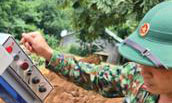 First Steps to Limiting Conflict Pollution in Central Vietnam
First Steps to Limiting Conflict Pollution in Central Vietnam
September 15, 2021: Awareness and concern are growing worldwide regarding pollution resulting from conflicts. In Vietnam, decades of wars have left a legacy of contaminated land and increasingly polluted water...
-
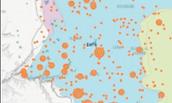 Measuring Explosive Munitions Use with Open-Source Data: A New Tool for Enhancing Humanitarian Mine Action [ includes CISR EXCHANGE audio clip ]
Measuring Explosive Munitions Use with Open-Source Data: A New Tool for Enhancing Humanitarian Mine Action [ includes CISR EXCHANGE audio clip ]
September 15, 2021: Since 2011, there has been widespread use of explosive weapons—including conventional weapons, improvised explosive devices (IEDs), and landmines—by all sides in the Syrian conflict...
-
 The Elusive “Just Enough”: Re-inventing Explosive Hazard Clearance Management in Iraq
The Elusive “Just Enough”: Re-inventing Explosive Hazard Clearance Management in Iraq
September 15, 2021: The Government of Iraq viewed rehabilitation of infrastructure contaminated with explosives during the conflict with the Islamic State of Iraq and the Levant (ISIL) as a prerequisite to socioeconomic recovery...
-
 Managing Risk Through Transparency and Cooperation: Improving Lebanon’s PSSM Capacity
Managing Risk Through Transparency and Cooperation: Improving Lebanon’s PSSM Capacity
September 15, 2021: Weapons and ammunition management is a global issue in which nations are responsible for the physical security and stockpile management of weapons and ammunition...
-
 Assisting Landmine Survivors in Yemen
Assisting Landmine Survivors in Yemen
September 15, 2021: Over the past ten years, with funding from the U.S. Department of State, the Marshall Legacy Institute’s (MLI) Mine Victim’s Assistance Program (MVA) has helped over 800 male, female, and child landmine survivors...
-
 Remote Sensing and Artificial Intelligence in the Mine Action Sector
Remote Sensing and Artificial Intelligence in the Mine Action Sector
September 15, 2021: Remote sensing and artificial intelligence (AI) technologies are included in discussions of how technology and innovation can improve humanitarian action and international peacekeeping...
-
 How to Implement Drones and Machine Learning to Reduce Time, Costs, and Dangers Associated with Landmine Detection
How to Implement Drones and Machine Learning to Reduce Time, Costs, and Dangers Associated with Landmine Detection
September 15, 2021: Two rapidly emerging technologies revolutionizing scientific problem solving are unpiloted aerial systems (UAS), commonly referred to as drones, and deep learning algorithms. Our study combines these two technologies...
-
 Volume 25, Issue 1 (2021)
Volume 25, Issue 1 (2021)
September 15, 2021: Read articles from The Journal of Conventional Weapons Destruction (Vol. 25, Issue 1 - Sept. 2021)


